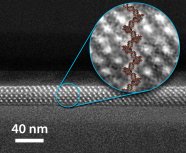Bryan Kaehr, Jason L. Townson, Robin M. Kalinich, Yasmine H. Awad, B.S. Swartzentruber, Darren R. Dunphy, and C. Jeffrey Brinker
Tissue-derived cultured cells exhibit a remarkable range of morphological features in vitro, depending on phenotypic expression and environmental interactions. Translation of these cellular architectures into inorganic materials would provide routes to generate hierarchical nanomaterials with stabilized structures and functions. Here, we describe the fabrication of cell/silica composites (CSCs) and their conversion to silica replicas using mammalian cells as scaffolds to direct complex structure formation. Under mildly acidic solution conditions, silica deposition is restricted to the molecularly crowded cellular template. Inter- and intracellular heterogeneity from the nano- to macroscale is captured and dimensionally preserved in CSCs following drying and subjection to extreme temperatures allowing, for instance, size and shape preserving pyrolysis of cellular architectures to form conductive carbon replicas. The structural and behavioral malleability of the starting material (cultured cells) provides opportunities to develop robust and economical biocomposites with programmed structures and functions.
|
click image for more information |
|
|
The targeted delivery of multicomponent cargos to cancer cells by nanoporous particle-supported lipid bilayers Carlee E. Ashley, Eric C. Carnes, Genevieve K. Phillips, David Padilla, Paul N. Durfee, Page A. Brown, Tracey N. Hanna, Juewen Liu, Brandy Phillips, Mark B. Carter, Nick J. Carroll, Xingmao Jiang, Darren R. Dunphy, Cheryl L. Willman, Dimiter N. Petsev, Deborah G. Evans, Atul N. Parikh, Bryce Chackerian, Walker Wharton, David S. Peabody & C. Jeffrey Brinker A nanocarrier—synthesized by the fusion of liposomes to spherical, nanoporous silica particles and subsequent modification of the lipid bilayer with targeting peptides and fusogenic peptides—shows the targeted delivery and controlled release of chemically diverse multicomponent cargos within the cytosol of certain cancer cells. |
Cell-Specific Delivery of Diverse Cargos by Bacteriophage MS2 Virus-Like Particles Carlee E. Ashley, Eric C. Carnes, Genevieve K. Phillips, Paul N. Durfee, Mekensey D. Buley, Christopher A. Lino, David P. Padilla, Brandy Phillips, Mark B. Carter, Cheryl L. Willman, C. Jeffrey Brinker, Jerri do Carmo Caldeira, Bryce Chackerian, Walker Wharton, and David S. Peabody Virus-like particles (VLPs) of bacteriophage MS2 possess numerous features that make them well-suited for use in targeted delivery of therapeutic and imaging agents. MS2 VLPs can be rapidly produced in large quantities using in vivo or in vitro synthesis techniques. Their capsids can be modified in precise locations via genetic ... |






